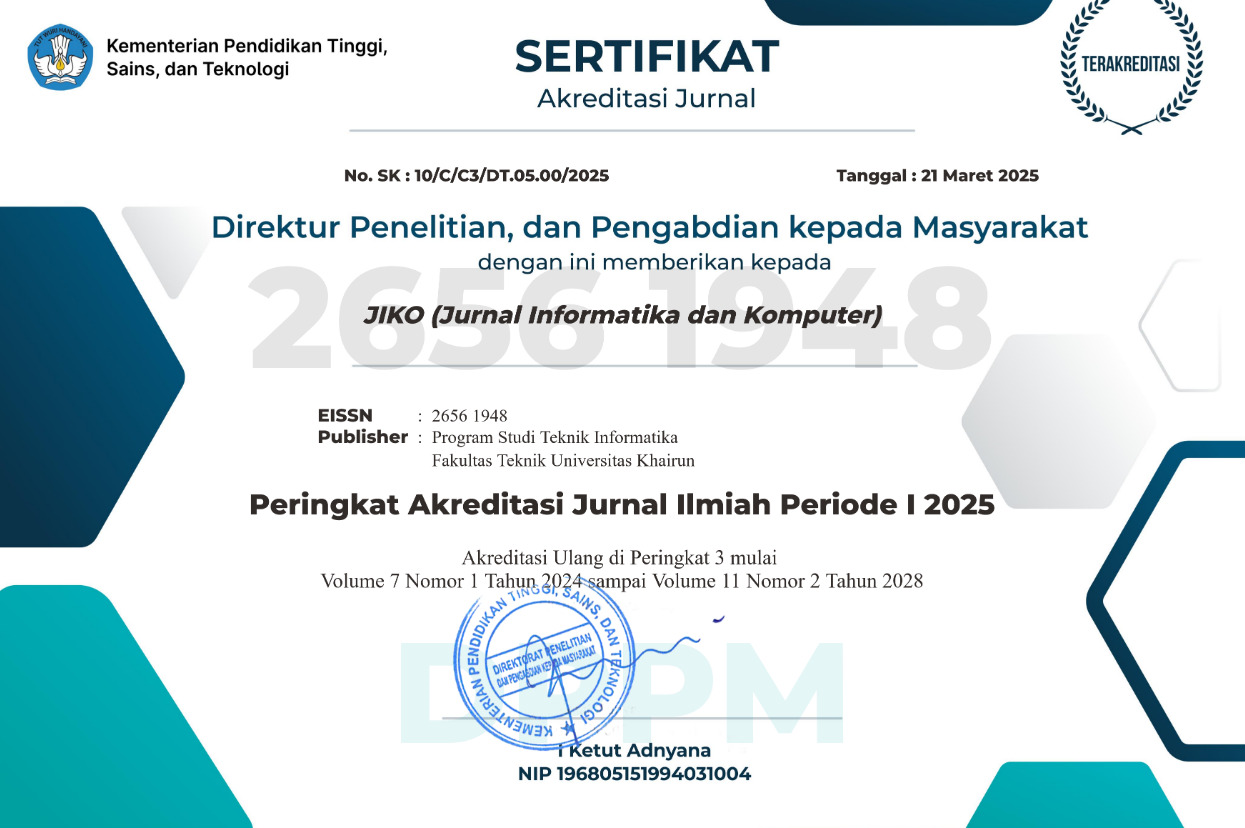ANALYSIS THE METAVERSE ADOPTION OF BATAM CITY MICRO, SMALL, MEDIUM ENTERPRISES USING TECHNOLOGY ACCEPTANCE MODEL
Abstract
The technological advancements and widespread adoption, particularly in the realm of the metaverse have introduced numerous innovations into human life. The societal adaptation process to these innovations is crucial for efficiency and sustainability. This research examines the factors influencing the acceptance of metaverse technology innovation, which is one of the most significant innovations in recent times. In this context, metaverse technology is analyzed using a Structural Equation Modeling (SEM) approach within the framework of the Technology Acceptance Model (TAM). The software Smart PLS 4.0 is employed for analysis to test the significant positive correlations found between perceived use, perceived usefulness, and intention to use. The results indicate that the perceived usefulness of the Metaverse does not influence the intention to use it among micro, small, and medium enterprises (MSMEs) in Indonesia. However, perceived use is shown to influence perceived usefulness and the intention to use the Metaverse among MSMEs. These findings suggest that while MSMEs may recognize the potential benefits of the Metaverse, they may not see it as a practical tool for their specific needs. It is important for developers of the Metaverse to address these concerns and demonstrate its value in order to increase adoption.
Full Text:
PDFReferences
E. Eryc, “Studi Prospektif Metaverse dan NFT bagi Pengguna NFT, Komunitas Game dan Trader Crypto Currency,†J. Ilm. Teknol. Inf. Asia, vol. 17, no. 2, pp. 117–124, 2023, doi: https://doi.org/10.32815/jitika.v17i2.928.
E. Eryc and C. Cindy, “Adoption Of Eco-Innovation And Digitalization Influence On The Business Performance Of Umkm In Batam City,†J. Teknol. Inf. DAN Komun., vol. 14, no. 1, pp. 67–77, 2023.
Y. Zhao et al., “Metaverse: Perspectives from graphics, interactions and visualization,†Vis. Informatics, vol. 6, no. 1, pp. 56–67, 2022, doi: 10.1016/j.visinf.2022.03.002.
Kye Bokyung, Han nara, Kim Eunji, Park Yeonjeong, and Jo Soyoung, “Educational applications of metaverse: possibilities and limitations,†J. Educ. Eval. Health Prof., 2021, [Online]. Available: https://www.ncbi.nlm.nih.gov/pmc/articles/PMC8737403/#:~:text=The potential of the metaverse,and high immersion through virtualization.
J. Björkdahl, “Strategies for Digitalization in Manufacturing Firms,†Calif. Manage. Rev., vol. 62, no. 4, pp. 17–36, 2020, doi: 10.1177/0008125620920349.
T. Ritter and C. L. Pedersen, “Digitization capability and the digitalization of business models in business-to-business firms: Past, present, and future,†Ind. Mark. Manag., vol. 86, pp. 180–190, 2020, doi: 10.1016/j.indmarman.2019.11.019.
A. Basaure, A. Vesselkov, and J. Töyli, “Internet of things (IoT) platform competition: Consumer switching versus provider multihoming,†Technovation, vol. 90–91, 2020, doi: 10.1016/j.technovation.2019.102101.
G. Sembiring Depari, E. Shu, and Indra, “Big Data And Metaverse Toward Business Operations In Indonesia,†J. Ekon., vol. 11, no. 1, pp. 285–291, 2022, [Online]. Available: http://ejournal.seaninstitute.or.id/index.php/Ekonomi
iy Qomarrullah, J. Siahaan, and M. Sawir, “Pengenalan Digital Literasi ‘Metaverse’ (Tantangan dan Potensi E-Sport di Tanah Papua),†J. Altifani, vol. 2, no. 4, pp. 334–341, 2022.
R. Ridwan, A. Wulandari, and ..., “Metaverse Regulation Formulation in Indonesian Cyber Law,†… Transform. Law, 2022, [Online]. Available: https://proceedings.ums.ac.id/index.php/icrtlaw/article/view/1118%0Ahttps://proceedings.ums.ac.id/index.php/icrtlaw/article/download/1118/1094
Y. Indarta, A. Ambiyar, A. D. Samala, and R. Watrianthos, “Metaverse: Tantangan dan Peluang dalam Pendidikan,†J. Basicedu, vol. 6, no. 3, pp. 3351–3363, 2022, doi: 10.31004/basicedu.v6i3.2615.
M. K. A. Al Gnbri, “Internal auditing in metaverse world: between the prospects of virtual reality and the possibilities of augmented reality,†Indones. Account. Rev., 2022, [Online]. Available: https://www.researchgate.net/profile/Mohamed-Kais-Al-Gnbri-2/publication/358262405_Internal_Auditing_in_Metaverse_World_Between_the_Prospects_of_Virtual_Reality_and_the_Possibilities_of_Augmented_Reality/links/6317b87061e4553b956dc907/Internal-Auditing-in
Y. TORAMAN and B. B. GEÇİT, “User Acceptance of Metaverse: An Analysis for e-Commerce in the Framework of Technology Acceptance Model (TAM),†Sosyoekonomi, pp. 85–104, 2023, doi: 10.17233/sosyoekonomi.2023.01.05.
E. Mardoyo, M. Lubis, and S. B. Bhaskoro, “Evaluasi Virtual Reality Menggunakan Technology Acceptance Model (TAM) Terkait Dunia Metaverse,†pp. 182–194, 2022.
H. Ning et al., “A Survey on Metaverse: the State-of-the-art, Technologies, Applications, and Challenges,†2021, [Online]. Available: http://arxiv.org/abs/2111.09673
Y. K. Dwivedi et al., “Metaverse beyond the hype: Multidisciplinary perspectives on emerging challenges, opportunities, and agenda for research, practice and policy,†Int. J. Inf. Manage., vol. 66, 2022, doi: 10.1016/j.ijinfomgt.2022.102542.
A. M. Aburbeian, A. Y. Owda, and M. Owda, “A Technology Acceptance Model Survey of the Metaverse Prospects,†Ai, vol. 3, no. 2, pp. 285–302, 2022, doi: 10.3390/ai3020018.
S. N. Attuquayefio and H. Addo, “Using the UTAUT model to analyze students ’ ICT adoption,†Intenational J. Eucation Dev. Using Inf. Commun. Technol., vol. 10, no. 3, pp. 75–86, 2014.
V. Venkatesh and H. Bala, “Technology acceptance model 3 and a research agenda on interventions,†Decis. Sci., vol. 39, no. 2, pp. 273–315, 2008, doi: 10.1111/j.1540-5915.2008.00192.x.
J. F. Hair, C. M. Ringle, and M. Sarstedt, “PLS-SEM: Indeed a silver bullet,†J. Mark. Theory Pract., vol. 19, no. 2, pp. 139–152, 2011, doi: 10.2753/MTP1069-6679190202.
DOI: https://doi.org/10.33387/jiko.v6i3.6719
Refbacks
- There are currently no refbacks.











